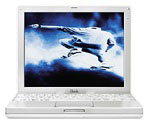
Hands On: iBook vs. Upgraded WallStreet
Rob Art Morgan -
2001.08.02
Two weeks ago, my wife purchased an iBook 2001 to replace her
WallStreet. Even
though I had pumped up her  WallStreet with a
G4/466 MHz CPU, 20 GB hard drive, and 192 MB of RAM, she was frustrated
with the hassles associated with using FireWire and USB devices via
CardBus.
WallStreet with a
G4/466 MHz CPU, 20 GB hard drive, and 192 MB of RAM, she was frustrated
with the hassles associated with using FireWire and USB devices via
CardBus.
For starters, CardBus FireWire doesn't support bus powered FireWire
devices. That means you have to carry around an AC adapter for every
FireWire device used on the WallStreet. Some FireWire devices (like a
FlashCard reader) don't have an AC adapter, much less a hole to plug
one in. That meant carrying around a FireWire hub to supply the power
(although that turned out to be a powerful solution since the Belkin
hub supports up to six bus powered FireWire devices).
USB was another story. If we put the WallStreet to sleep with the
USB CardBus card plugged in, it wouldn't wake up. No amount of trouble
shooting would fix this. This meant ejecting the USB card every time
you went to sleep.
Replacing the WallStreet with the smaller, lighter iBook 2001 with
its built-in FireWire and USB was a solution too tempting to pass up.
We chose the cheapest iBook at $1,295. (The dealer threw in a
three-year extended warranty including screen replacement, since the
unit was a "return.") We added the new 512 MB upgrade from TransIntl.com, which at $289 is a fraction
of the cost of the same upgrade elsewhere. That's a bargain when you
consider that Apple charges $200 for the 128 MB upgrade at their online
store!
We debated about getting the model with the either the CD-RW or
DVD/CD-RW Combodrive but decided against it because we wouldn't sit and
watch DVD movies on a 12" screen, and we could back up the drive and
burn CDs using her G4/500
Desktop (with the iBook in FireWire Target Mode) when she's back at
home base.
The day after purchasing the iBook, she went on a two week photo
shoot in California. She couldn't be happier. I did send her off with
one of my spare 20 GB external 2.5" FireWire drives, recommending she
back up all her uploaded/edited photos on it as a precaution. I
installed a backup System Folder on the external drive as well, just in
case she needed to boot from it. By the way, the external FireWire
drive runs circles around the internal 10 GB. When you boot from it,
the iBook starts up much faster. (I'll be reporting on this later on
Bare Feats.)
Looking back, I'm having second thoughts about not getting at least
the CD-RW drive version. She could have been burning CDs as a backup
measure without having another piece of hardware to carry around. I
told her we could return the unit and upgrade, but she doesn't want to.
She's very happy with her purchase and loves having the small external
bus-powered FireWire drive as backup/extra storage. In other words,
she's not giving the loaner back. Besides, for the $249 the "911" 2.5"
FireWire drive costs at TransIntl.com, she gets a total of 30 GB of
storage compared to the $200 Apple charges for 20 GB internal drive
upgrade on their online store.
The keyboard took some getting used to. It doesn't have the great
feel of the WallStreet keyboard, but it's okay. What the screen lacks
in size, it makes up for in brightness. And if they made it any bigger,
the size of the iBook would have to be increased. And the G3/500 CPU is
not quite as fast as the G3/466 MHz WallStreet with its 1 MB L2
cache, but she doesn't have a stopwatch like me and can't feel the
difference.
Although I've got the WallStreet up for sale now, I wouldn't shed a
tear if it didn't sell. I like the old rugged beast with its "hide the
scratches" dark finish, versatile hot swap bays, and easily upgradeable
CPU. In fact, maybe it will take so long to sell, I'll have time to
test a G4 upgrade from PowerLogix or Sonnet or whomever.
Rob Art Morgan lives in
Hawaii and is the publisher of
Bare
Feats, one of our favorite Mac benchmark sites.
Share your perspective on the Mac by emailing with "My Turn" as your subject.

 WallStreet with a
G4/466 MHz CPU, 20 GB hard drive, and 192 MB of RAM, she was frustrated
with the hassles associated with using FireWire and USB devices via
CardBus.
WallStreet with a
G4/466 MHz CPU, 20 GB hard drive, and 192 MB of RAM, she was frustrated
with the hassles associated with using FireWire and USB devices via
CardBus.
